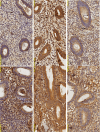Chemokines and Their Association With Symptom Severity in Women With Endometriosis
- PMID: 40906442
- PMCID: PMC12410295
- DOI: 10.1111/aji.70156
Chemokines and Their Association With Symptom Severity in Women With Endometriosis
Abstract
Problem: Various chemokines have been linked to endometriosis. Notably, chemokines such as CCL2, CXCL8, and CXCL1 have also been shown to promote nociception. In this study, we investigated whether increased serum concentrations and endometrial expression of chemokines (specifically CCL2, CXCL8, and CXCL1) are associated with heightened severity of pain symptoms in women with endometriosis.
Method of study: The study included women with endometriosis (with [n = 27] and without [n = 24] hormonal treatment) as well as healthy controls (n = 22). All participants underwent blood sampling and an endometrial biopsy during the secretory phase of the menstrual cycle. Symptom severity in the patient group was assessed using the pain dimension of the Endometriosis Health Profile 30 (EHP-30) and a visual analog scale (VAS) for pain.
Results: Serum levels of CCL2 and CXCL1, as well as endometrial expression of CXCL8, were lower in women with endometriosis compared to controls. Furthermore, increased serum levels of CCL2, CXCL8, and CXCL1 were associated with higher EHP-30 pain domain scores in women with endometriosis. Similarly, elevated endometrial expression of CXCL8 and CXCL1 correlated with higher VAS scores. Notably, when the patient group was stratified based on ongoing hormonal treatment, CXCL1 emerged as the most promising target, with both increased serum concentration and endometrial expression consistently being associated with greater symptom severity.
Conclusions: Our results suggest that chemokines, particularly CXCL1, are associated with greater pain severity and reduced quality of life in women with endometriosis. However, these correlations do not establish causality and should be interpreted with caution.
Keywords: CCL2; CXCL1; CXCL8; chemokine; endometriosis; pain.
© 2025 The Author(s). American Journal of Reproductive Immunology published by John Wiley & Sons Ltd.
Conflict of interest statement
The authors declare no conflicts of interest.
Figures


References
-
- Facchin F., Barbara G., Saita E., et al., “Impact of Endometriosis on Quality of Life and Mental Health: Pelvic Pain Makes the Difference,” Journal of Psychosomatic Obstetrics and Gynaecology 36, no. 4 (2015): 135–141. - PubMed
-
- Siedentopf F., Tariverdian N., Rucke M., Kentenich H., and Arck P. C., “Immune Status, Psychosocial Distress and Reduced Quality of Life in Infertile Patients With Endometriosis,” American Journal of Reproductive Immunology 60, no. supplement 5 (2008): 449–461. - PubMed
-
- Olovsson M., “Immunological Aspects of Endometriosis: An Update,” American Journal of Reproductive Immunology 66, no. S1 (2011): 101–104. - PubMed
-
- Graves D. T. and Jiang Y., “Chemokines, a Family of Chemotactic Cytokines,” Critical Reviews in Oral Biology & Medicine 6, no. 2 (1995): 109–118. - PubMed
-
- Borrelli G. M., Abrão M. S., and Mechsner S., “Can Chemokines be Used as Biomarkers for Endometriosis? A Systematic Review,” Human Reproduction 29, no. 2 (2014): 253–266. - PubMed
MeSH terms
Substances
Grants and funding
LinkOut - more resources
Full Text Sources
Medical
Research Materials

